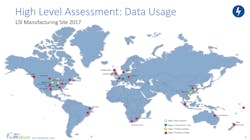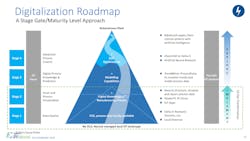Processor adapts advanced analytics to improve operations
At last year’s OSIsoft PI World conference in Gothenburg, Sweden, Lonza’s global operational technology manager, Dr. Tobias Merz, gave a presentation describing the Lonza Specialty Ingredients segment’s journey to obtain actionable, information-based insights from its data.
Lonza Specialty Ingredients focuses on microbial control for personal care as well as for protecting homes, schools, workplaces and the environment from mold and other potential pathogens. It also offers performance intermediates and chemicals, custom development and manufacturing, and composites to support the electronics, aerospace, food and agrochemical industries.
The technology solution, which combines OSIsoft PI System data with Seeq’s advanced analytics, provides the company’s experts with 24/7 access to plant performance and enables them to run statistical analysis, create models for predictive analytics, compare batches and present static and updated insights in Seeq dashboards.
More than 530 users companywide (engineers, bio technologists, chemists, scientists, managers and those from other departments) now have access to these capabilities. According to the company, the resulting benefits include massive time savings, improved data sharing and enhanced collaboration, improved productivity and better product quality.
Data maturity assessment
To get a better understanding of how the company was using its manufacturing data, it completed a data usage maturity assessment at its major life science industry (LSI) manufacturing sites in 2017 (Figure 1). The assessment reviewed what different sites were doing with their process data or historians, if process data was available, if they had visualization tools, and if they were doing analytics on the data.
The results of the assessment were color-coded by site. Red dots indicate that either no data was available, that the sites do not use the data, or do not know that they have it. Yellow dots indicate that the PI system is available, but the site did not do a lot with the data. Green dots indicate the sites that were more active in using OSIsoft PI Vision or PI ProcessBook for data visualization. The team determined that none of the sites were doing advanced analytics on the data when they began the assessment in 2016.
Operations challenges
Lonza’s central hub for subject matter experts (SMEs) is in Switzerland. The SMEs have expertise in areas such as thermal separation, fermentation, particle technology, formulation and process analytical technology (PAT). Their mission is to collaborate with production to help solve complex problems. The company determined that — by providing the SMEs with a better understanding of the information at the different sites through real-time dashboards, historical data reports and advanced analytic tools — it could improve collaboration companywide and empower the people using the data from the OSIsoft PI system. The company also decided the SMEs could support the local production sites remotely to help them find and detect potential optimization opportunities.
Dr. Merz and his team determined the company needed to move away from Excel spreadsheets and digitalize the data using its PI system collaborative infrastructure to make operational improvements. This would enable them to combine people, processes and technology, helping the SME hub experts improve production.
Steps to digitalization
The first maturity stage for the digitalization roadmap was getting the data from each site to evaluate the current installed base and then connecting the data to the PI System (Figure 2). The second stage was visualizing each site’s assets and the process. Currently, the company is focused on stage 2: making sense of the data and obtaining actionable insights.
Future stages will be improving process understanding from the data, visualizing data trends, modeling the process and using more advanced process control. Lonza’s ultimate vision is autonomous production — including integrated operations in the value chain, from logistics to warehousing to supply chain to inventory — on a global basis.
The team worked with each site to determine their specific challenges or pain points, along with what data analytics technology or capabilities would be needed to eliminate those site-specific pain points. These varied depending on the respective site’s data maturity level (Figure 3).
The team found a large number of spreadsheets being used in production at different sites — the majority dedicated to detecting batch phases or other specific information. Many of the original Excel owners had retired, making it difficult to support many of these spreadsheets.
They also evaluated different visualization requirements for implementation. Dashboard needs included but were not limited to:
- Batch phase recognition based on PI tags.
- SPC tables.
- Automatic recognition of unit operations.
- Multi-batch alignment and comparisons.
- Monitoring setpoint variations.
- Calculating batch durations.
The technology solution
Based on which tools aligned best with the various business challenges and user requirements, the company selected three potential products to test and compare with the operations end users. These products included Lonza’s own proprietary technology and two commercial solutions. After identifying appropriate use cases with measurable benefits, an initial group of eight to 10 people tested each of the products in conjunction with the company’s project database and then conveyed the advantages and benefits of each.
After three months of using the tools, Seeq was ultimately selected because it enabled the operations users to easily get the needed information. The other tools did not have the same level of user acceptance during testing. By the end of the trial, Seeq usage had tripled. The Seeq tools fulfilled the end users’ requirements for process analytics and other information, and the price and licensing contract also met Lonza’s needs.
Seeq rollout
The company selected Seeq for the advanced analytics rollout in 2016. It went rapidly from 15 to 40 users, and they are now over 530 users (Figure 4). Currently, Lonza has rolled out the Seeq–PI system solution to 10 different sites on 12 connected PI servers and six PI Asset Frameworks. The company has around 150 processes being monitored and analyzed from 7,500 dashboards.
Users around the world have access to the data and analysis. The company tracked the usage of Seeq’s service per month and found that the more people used Seeq, the more time they spend solving problems. (The decline in usage in August was attributed to vacations.)
The benefits
The company surveyed the users about the Seeq tool and found 95% were satisfied. According to one user, “Seeq is a great tool and enables us to elevate data and perform data evaluations by ourselves.” Most of the applications were for process monitoring, performance and optimization. At just one Lonza site, the company saved over 15,000 hours and increased yields from 1% to as much as 10%.
According to Brian Schwegler, solvent recovery manager with Lonza, “Seeq has been a great tool because it gives me a quick overview of several different processes that are running. I can come in the office on Monday morning and, within ten minutes, see what went on over the weekend in five different processes. This includes how many batches were made, the size of the batches, and quickly identifying and isolating any problems. This type of information would have taken a lot longer to obtain previously. As a solvent recovery manager with a portfolio of different products, it’s a very efficient tool for me to use.”
As a self-service tool, it did not take Lonza long to train the engineers and other expert knowledge workers to use Seeq. Generally, it is easier to train engineers and other domain experts to use the Seeq tool than it is to train data scientists to be process knowledge workers.
Lonza found that the software provides an excellent way to investigate, collaborate and share data. The company is using the software to monitor production operations and process variables, as well as for logistics and other operations.
Recommendations
Based on ARC research and analysis, we recommend the following actions for owner-operators and other technology users looking to gain more value from their data and support digitalization:
- Start with a maturity assessment of the current situation.
- Work with the end users to help solve information and data bottlenecks.
- Work with a technology supplier to identify and implement an appropriate and focused pilot project, with the potential to scale up quickly and provide measurable business benefit with low-risk and cost-effective deployment.
- Measure the benefits.
- Roll out the solution and enable more end users with access to the technology.
Janice Abel is a lead analyst for the ARC Advisory Group in the areas of enterprise manufacturing intelligence, manufacturing execution systems, operational analytics, batch management software and operator training simulators. She has done extensive research and consulting on automation technologies spanning the entire spectrum of process and manufacturing industries. Her experience includes over 30 years of helping both suppliers and end-user clients develop strategic plans to market, adopt and use technologies. Abel has been doing research and consulting for the chemical, oil and gas, pharmaceutical and biopharmaceutical, consumer products, medical devices and other industries throughout most of her professional career. At ARC, her technology focus is on operational data, advanced operational analytics, data platforms, manufacturing execution systems, AR/VR and other technologies.
About the Author
Janice Abel
Janice Abel is a lead analyst for the ARC Advisory Group in the areas of enterprise manufacturing intelligence, manufacturing execution systems, operational analytics, batch management software and operator training simulators. She has done extensive research and consulting on automation technologies spanning the entire spectrum of process and manufacturing industries. Her experience includes over 30 years of helping both suppliers and end-user clients develop strategic plans to market, adopt and use technologies. Abel has been doing research and consulting for the chemical, oil and gas, pharmaceutical and biopharmaceutical, consumer products, medical devices and other industries throughout most of her professional career. At ARC, her technology focus is on operational data, advanced operational analytics, data platforms, manufacturing execution systems, AR/VR and other technologies. She is a frequent presenter at ARC and other conferences, including meetings on anti-counterfeiting and operational excellence, and she has authored numerous articles throughout her career. Prior to joining ARC, she was the director of pharmaceutical industry marketing at The Foxboro Company, Validation Technologies, and Invensys (now Schneider-Electric). Abel holds an M.S. in chemical engineering and an MBA, both from Worcester Polytechnic Institute.



